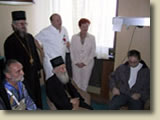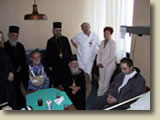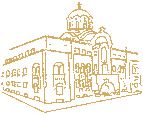| Information
Service of
the Serbian Orthodox Church
July 1, 2004

SERBIAN PATRIARCH AND MEMBERS OF HOLY ASSEMBLY
OF BISHOPS VISIT PROTOPRESBYTER-STAVROPHOR JEREMIJA AND ALEKSANDAR
STAROVLAH
HOSPITAL DIRECTOR: FATHER JEREMIJA AND CATECHIST ALEKSANDAR
WERE NOT WOUNDED BY EXPLOSIVES BUT HEAVILY BEATEN BY OTHERS
 His Holiness Serbian Patriarch Pavle together with the following
members of the Holy Assembly of Bishops: Bishop Irinej of Nis,
Bishop Jovan of Sumadija, Bishop Joanikije of Budimlje and Niksic
and Metropolitan Nikolaj of Dabro-Bosnia visited Protopresbyter-Stavrophor
Jeremija Starovlah and his son, Catechist Aleksandar Starovlah,
at the Military Medical Academy in Belgrade where they have been
receiving medical treatment for injuries inflicted the night
of April 1, 2004 during an attack by SFOR troops. His Holiness Serbian Patriarch Pavle together with the following
members of the Holy Assembly of Bishops: Bishop Irinej of Nis,
Bishop Jovan of Sumadija, Bishop Joanikije of Budimlje and Niksic
and Metropolitan Nikolaj of Dabro-Bosnia visited Protopresbyter-Stavrophor
Jeremija Starovlah and his son, Catechist Aleksandar Starovlah,
at the Military Medical Academy in Belgrade where they have been
receiving medical treatment for injuries inflicted the night
of April 1, 2004 during an attack by SFOR troops.
 Father Jeremija and Aleksandar Starovlah greeted His Holiness
and the bishops on their feet and in much better physical condition
than during the previous visit. Pleased with the progress they
had shown, Patriarch Pavle expressed the hope that they would
soon be able to leave the hospital and continue their treatment
on an outpatient basis. Present with Military Medical Academy
director, General-Colonel Dr. Zoran Stankovic, Section for Morale
and Information director, General-Major Vidosav Kovacevic, and
the department heads of the most important military health institute
was Dr. Mirsada Praso, the head of the Department of Anesthesiology
of the University Clinical Center in Tuzla, where the two wounded
men were admitted the night of April 1, who was exceptionally
successful in providing them with emergency medical assistance.
The physicians informed the Patriarch and the bishops regarding
the patients’ condition upon admittance and during the course
of their treatment. Father Jeremija and Aleksandar Starovlah greeted His Holiness
and the bishops on their feet and in much better physical condition
than during the previous visit. Pleased with the progress they
had shown, Patriarch Pavle expressed the hope that they would
soon be able to leave the hospital and continue their treatment
on an outpatient basis. Present with Military Medical Academy
director, General-Colonel Dr. Zoran Stankovic, Section for Morale
and Information director, General-Major Vidosav Kovacevic, and
the department heads of the most important military health institute
was Dr. Mirsada Praso, the head of the Department of Anesthesiology
of the University Clinical Center in Tuzla, where the two wounded
men were admitted the night of April 1, who was exceptionally
successful in providing them with emergency medical assistance.
The physicians informed the Patriarch and the bishops regarding
the patients’ condition upon admittance and during the course
of their treatment.
 Father Jeremija was admitted to the Orthopedic and Traumatological
Clinic where he underwent surgery on his right upper arm and
received treatment for a broken rib. After appropriate measures
were taken, a significant improvement resulted and Father Jeremija
is in good physical condition, which will be enhanced by further
physical therapy. His son, Catechist Aleksandar, was admitted
with a severe brain concussion resulting from a broken arcade
and the base of the skull after the removal of an epidural hematoma
at Tuzla Hospital. After intensive therapy, his treatment continued
at the Neurosurgical Clinic with further complications appearing
during the course of his hospitalization, which have been successfully
treated by multidisciplinary therapies. Aleksandar still suffers
from damage to his sight from the left eye and other treatable
consequences. Father Jeremija was admitted to the Orthopedic and Traumatological
Clinic where he underwent surgery on his right upper arm and
received treatment for a broken rib. After appropriate measures
were taken, a significant improvement resulted and Father Jeremija
is in good physical condition, which will be enhanced by further
physical therapy. His son, Catechist Aleksandar, was admitted
with a severe brain concussion resulting from a broken arcade
and the base of the skull after the removal of an epidural hematoma
at Tuzla Hospital. After intensive therapy, his treatment continued
at the Neurosurgical Clinic with further complications appearing
during the course of his hospitalization, which have been successfully
treated by multidisciplinary therapies. Aleksandar still suffers
from damage to his sight from the left eye and other treatable
consequences.

After the visit, His Holiness Patriarch Pavle, the members of
the Holy Assembly of Bishops, Military Medical Academy director
Dr. Zoran Stankovic, physicians involved in the treatment and
Dr. Mirsada Praso held an exceptionally well-attended press conference.
The Serbian Patriarch expressed his gratitude to the staff of
the Military Medical Academy and especially to Dr. Mirsada Praso
and the staff of the University Clinical Center in Tuzla who,
with God’s help and thanks to their great personal efforts and
expertise, were exceptionally successful in their treatment of
these two clerics of the Serbian Orthodox Church. His Holiness
was especially emphatic regarding the importance of determining
the circumstances under which they were injured. For Christians
truth is not merely a relationship among ideas and material objects
but an essential thing for the Lord Himself said: “I am the way,
and the truth, and the life” (John 14:6).
Dr. Mirsada Praso said that all medical staff of the University
Clinical Center in Tuzla involved in the Starovlah case did their
best to assist in the recovery of Father Jeremija and Aleksandar
Starovlah, and added that she personally was very pleased by
their rapid recovery.
Metropolitan Nikolaj of the Diocese of Dabro-Bosnia expressed
his deepest thanks to Dr. Praso and all medical staff of Tuzla
Hospital.
Answering questions by reporters, General-Colonel Dr. Zoran
Stankovic, the director of the Military Medical Academy, said
that based on the intensity, distribution and number of injuries,
it is clear they were not inflicted by explosives but by physical
actions and blows with objects inflicted by one or more persons.
All further details need to be established by the appropriate
court officials, said Dr. Stankovic.

MEETING OF PATRIARCH PAVLE WITH DR MICHAEL WENNINGER, SENIOR
OFFICIAL OF THE EUROPEAN COMMISSION  His Holiness Serbian Patriarch Pavle together with members of
the Holy Assembly of Bishops received Dr. Michael Wenninger,
the political consultant to the President of the European Commission,
Roman Prodi. His Holiness Serbian Patriarch Pavle together with members of
the Holy Assembly of Bishops received Dr. Michael Wenninger,
the political consultant to the President of the European Commission,
Roman Prodi.
Welcoming his guest, His Holiness emphasized that it is a great
honor for him personally and for the Serbian Orthodox Church
to receive such a renowned and very important politician, diplomat
and deeply devout man and speak with him regarding current key
issues, especially regarding the difficult living conditions
of the Serbs in Kosovo and Metohija. Dr. Wenninger assured the
Serbian Patriarch that everyone in the European Commission is
aware of the exceptionally difficult position of the Serbian
people, the Serbian Orthodox Church and Orthodox holy shrines
in Kosovo and Metohija. According to Dr. Wenninger, the goal
is to show that adequate protection of Serbian patrimonial sites
is a condition for Europe’s further cooperation with Kosovo institutions.
Dr. Wenninger expressed support and emphasized the need to continue
informing the international community regarding the destruction
of Serbian churches in Kosovo and Metohija. Dr. Wenninger emphasized
that he and Roman Prodi had prepared a publication on the protection
of religious objects on the territory of eight Eastern European
countries and that he expects the poster depicting a photograph
of the torched church of Bogorodica Ljeviska (the Holy Virgin
of Ljevis) in Prizren and the publication to have impact on the
public. This notable politician is also responsible for the First
Conference of Academy Presidents in Venice where current problems
in our region were discussed. A second conference is scheduled
to be held in Budva at the end of October of this year. At the
conclusion of the meeting both parties expressed the desire to
protect and preserve the Serbian people and their holy shrines
in Kosovo and Metohija.

STATEMENT OF THE NEWLY ELECTED BISHOP JOVAN PURIC
The only thing that has been restored for now
is the Dioclean title, meaning the re-establishment of the ancient
bishop’s title that confirms the uninterrupted continuity of
its existence in this region. The Diocese of Zeta – the present-day
Metropolitanate of Montenegro and the Littoral of which I am
a vicar (auxiliary) bishop with the aforementioned title – is
located in the same geographic region where a bishop’s cathedra
already existed in earlier historical times (in Dioclea, Zlatica,
Londodoclea). By its very location the new bishop’s cathedra
(of Zeta) to some extent enjoyed continuity with the Diocese
of Dioclea, which in the meanwhile was extinguished (11th-12th
centuries). The seat was transferred from Podgorica to the monastery
of St. Michael on Prevlaka. In the ensuing centuries the bishop’s
cathedra no longer existed on the territory of greater Podgorica.
Today’s residents of Podgorica and surroundings come to the monastery
of Ostrog to be baptized and accept Orthodoxy. By this very act
they are joining the medieval Diocese of Dioclea, i.e., the One
Holy Catholic and Apostolic Church. It is natural that the Abbot
of Ostrog should bear the title of the newly elected bishop,
reflecting the essential issues with respect to the mission of
the church and its pastoral role. Because of the special mission
of Ostrog, not only in Montenegro, but also in the Serbian Orthodox
Church, this represents a spiritual renewal among our people.
This also represents an important step relevant solely to church
policy, which should be differentiated from everyday political
and transient policy. The language spoken from the Ostrog source
is the language of faith, hope and love, the language of repentance
and brotherly reconciliation.
Therefore, the title of Bishop of Dioclea is the title of the
Archpastor of Christ’s Church in the early, mid-Byzantine, Roman-Romanic
Dioclea, a city created in the middle of the Zeta plain, at the
mouth of two rivers, the Moraca and the Zeta, near present-day
Podgorica, and later relocated as Londodoclea to the safer mountains
in the direction of Spuz, like some new Mt. Tavor, and today
to the fortress of Orthodoxy – Ostrog, once an ascetic monks’
cell, today “the city on the Mountain”. The Abbot of Ostrog is
enthroned in this City, which is visited not only the Orthodox
but also by the entire Christian world, and it is therefore suitable
that he bears the title of undivided Apostolic heritage. By this
move or decision on its part the Assembly of our Church has affirmed
the Diocese of Dioclea as the foundation of the spiritual heritage
in this region. This tradition must not be abandoned and forgotten
but must serve instead as an inexhaustible spring of spiritual
inspiration for present and future generations. Taking into account
the growing organizational and missionary needs of the Orthodox
Church in Montenegro and the Littoral, it was necessary to thus
express support and to reinforce the evangelical mission and
current spiritual renewal on the territory of the Metropolitanate,
which is under continuous threat... With this decision we advance
into the future unencumbered by the “reconstruction” of the past.
This is the first reason for the restoration of the Diocese
of Dioclea; the second reason is the determination of the Serbian
Orthodox Church to more strongly emphasize the inviolable and
uninterrupted continuity of its diocese on the territory of present-day
Montenegro by reaching far back to its Dioclean roots and “rightly
handling the word of truth” (2 Timothy 2:15) and protecting the
Church’s uncorrupted Teaching as the guarantee of our salvation.
This determination also implies the resoluteness of our Serbian
Orthodox Church not only to unmask the illegal pretensions of
atheist, pseudo-clerical and non-Orthodox church structures on
its canonic territory but to decisively attacks by the usurper
by the strength of Christ’s truth “and the powers of death shall
not prevail against it” (Matthew 16:18) and its objective and
irrefutable historical testimony.
And finally, as a term known to the more educated members of
the church, the name Dioclea has been in use in the standard
Serbian language during the entire Middle Ages as the only term
for the aforementioned geographical and historical concept. Only
in the 20th century did a vulgar form of it, distorted and croatized,
appear in folk speech – Duklja. Inevitably it resulted in the
elimination of the original form from literary use by the end
of the 20th century and, thanks primarily to Serbian historiography,
it was marginalized and completely replaced. Hence by restoring
this early Christian title in the twenty-first century the Serbian
Orthodox Church on the Ladder of mysterious ascent and in accordance
with higher reason will restore the lost national memory on this
plan as well. The difference between Dioclea and Duklja is not
merely phonetic nor is it merely an issue of the right to national
self-determination and ideological choice but essential and far
deeper. Our responsibility for our potential flock in this region
is consequently great. Come Judgment Day we, too, will have to
account for everything we could have done for this people but
failed to do because of our pride or prejudices.

PRAYER IN CACAK HOSPITAL A church dedicated to the Unmercenary Physicians Cosmas and
Damian will soon be consecrated at Cacak Hospital. Protopresbyter
Branko Kerkezovic said that Holy Services will be served here
for the patients and hospital staff. This hospital had its own
church before World War II where patients and staff prayed for
health and salvation.
Source: Politika daily, Belgrade, July 1, 2004 
ST VITUS DAY CELEBRATED IN DALMATIAN KOSOVO His Grace Bishop Fotije of Dalmatia served Holy Hierarchal Liturgy
on St. Vitus Day – Vidovdan with the concelebration of the diocesal
clergy and monks in the church of Lazarica in Dalmatian Kosovo.
In his sermon on this occasion Bishop Fotije emphasized the
two key factors that have guided the entire history of the Serbian
people: mass christianization in the time of Sts. Cyril and Methodius
and, by virtue of this fact, the entry of our people into the
Church of the Living God, and the Kosovo Covenant where, following
the model of Golgotha, we accepted sacrifice as the purpose of
our existence.

REQUIEM SERVICE FOR VICTIMS IN STRAZICA On St. Vitus Day – Vidovdan a memorial service was served at
the Strazica Memorial Center near Jama to the victims of Communist
terror. The memorial service in the Serbian Orthodox municipality
of Pljevlja was served with the blessing of His Grace Bishop
Filaret of Milesevo. A large number of local residents, members
of the families of the decease, representatives of the Serbian
People’s Party and others attended the service. After the service,
speakers at the commemoration included Momir Vojvodic, Acim Visnjic,
Novica Stanic and others.
Source: Politika daily, Belgrade, July 1, 2004

[Serbian
Translation Services]

Copyright © 1999-2004 by
The Information Service of
the Serbian Orthodox Church
11000 Belgrade
Kralja Petra I no.5
+381 11 3282 596
e-mail
|

